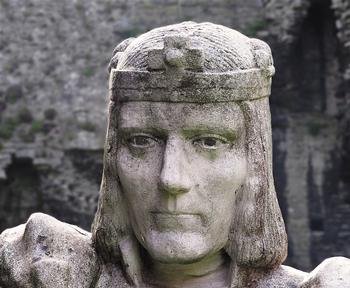Quiz Answer Key and Fun Facts
1. Richard was the son of Henry II and Eleanor of Aquitaine. Which child of this royal pair was he?
2. Richard was known by the cognomen "the Lionheart". He also had another cognomen, also based upon a characteristic. What was it?
3. Richard was a leader in which of the crusades?
4. When Richard went on crusade, whom did he nominate as his heir in case something happened to him while away?
5. In order to raise money for his crusade, what action(s) did Richard take?
6. According to gossip, Richard had an affair with his feudal lord Philip II (Augustus) of France.
7. Richard had for twenty years been betrothed to Philip's half sister. As a result of the betrothal, she had been raised at the court of Henry II. Who was that lady?
8. What was the most significant difference between the third crusade and the first and second crusades?
9. One of the leaders of the crusades placed his banner along side that of Richard. This provoked a reaction on the part Richard's men, resulting in the tearing down of the offending banner. Whose banner caused offence?
10. Who was the leader of the Muslim forces in the Third Crusade?
11. Before leaving on the crusade, Richard made his brother John and his half-brother Geoffrey swear that they would not return to England for a three year period. John was later released from this oath as the result of the pleading of which person?
12. Richard left authority in England divided between two justiciars. Hugh du Puiset, Bishop of Durham was made justiciar of the north. Who was appointed justiciar of the south?
13. One of the reasons that Richard chose Berengaria of Navarre as his bride was the hope that the Navarese would act to protect Richard's territories in the Aquitaine. This in fact was true and Berengaria's brother assisted in the reconquest after Richard returned from the crusade. Who was her brother?
14. Upon his return, Richard commanded that his designated heir, Arthur, come to his court to be educated there. Arthur's mother, a strong willed woman who detested the Angevins, refused to allow this believing it was an attempt on the part of Richard to gain control of her son with the idea of eliminating him. Who was this woman?
15. Richard was captured by Leopold, Duke of Austria, on his return from the crusade. Leopold had been angered by Richard's treatment of him during the battle of Acre and imprisoned him, although this was in violation of the crusader's oath. Prior to his being surrendered to Leopold's overlord, Emperor Henry VI, where was Richard imprisoned?
16. Upon his return to England and the re-establishment of his authority, Richard had a second coronation ceremony. Where did this ceremony take place?
17. Although William Longchamp was restored as chancellor upon Richard's return, he was not given the same authority that he had enjoyed when Richard left for the crusade. It was while exercising this authority, that he had been expelled from England. Richard made his Archbishop of Canterbury the chief justiciar, a position superior to that of chancellor. Who was this cleric?
18. In order to protect the 'gateway to Normandy', Richard had erected a strong castle. Nicknamed the 'saucy castle', what was the name of this castle of which Richard was very proud?
19. Berengaria was the only English queen never to reside in England.
20. Where was Richard buried?
Source: Author
tripeuro
This quiz was reviewed by FunTrivia editor
fringe before going online.
Any errors found in FunTrivia content are routinely corrected through our feedback system.


